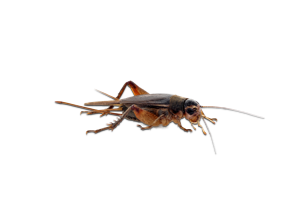Crickets

This time of year we are sort of in that “tweener” season when it may still be cold enough to keep bugs in hiding, but may have the warm days that get them moving outdoors too. A lot of insects do find homes to be wonderful places to spend the winter, so it’s possible this home managed to have a population of them inside. But, since you also are seeing dead crickets outside it sounds like you do have outside activity. Since I assume these are black “field” crickets it is unlikely that they can breed indoors or even survive for very long once they get inside. There would be little for them to eat and conditions indoors are probably too dry. They are generally only a nuisance. And, the fact that you are finding some inside the lights suggests they would be coming down into that light from above, meaning they were in the attic.
This does suggest that the gaps you are finding in the soffit could be one of the culprits. Crickets have no problem climbing exterior walls, and particularly if they feel the need to escape some weather conditions they would move to find a drier location. It sounds to me like you are doing what you need to do so far – closing entry points outside, treating the exterior perimeter to kill those that move along the base of the house, treating within the gaps you suspect they may enter. Some thoughts would be to do an even more thorough inspection of the exterior to identify more entry points and have these permanently closed, and “telling” the homeowner to do this and actually getting it done could be two separate things. If they are willing to pay you for your time this exclusion is certainly a legitimate part of the overall pest “management” process, and every gap you close is one less place for these or other bugs to enter, and one less place you’ll need to apply insecticides in the future.
Another part of this IPM approach to cricket control is identifying the contributing conditions on the property too, so it would be of value for the customer to take the slow walk around the yard and identify harborage opportunities that can be changed. Every time you take away a hiding place for a bug you tend to lower the bug population, and those places crickets hide are also harborage sites for rodents, snakes, and lots of other bugs. These are things the homeowner may just not think about, and would appreciate having pointed out to them.
At this point, if the entry gaps are closed and you feel no more crickets could be getting in from the outside, it may just be a waiting game. The crickets could live for weeks inside before dying from starvation or desiccation, so they will wander and show up for the homeowner now and then. If they are in the attic they may be drawn to gaps of light, such as above light fixtures in ceilings.
